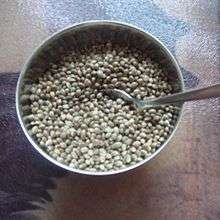Hemp oil
Hemp oil or hempseed oil is obtained by pressing hemp seeds. Cold pressed, unrefined hemp oil is dark to clear light green in color, with a nutty flavour. The darker the color, the grassier the flavour. It should not be confused with hash oil, a tetrahydrocannabinol-containing oil made from the Cannabis flower, hailed by some[1] for its medicinal qualities.[2]
Description
Refined hempseed oil is clear and colorless, with little flavor and lacks natural vitamins and antioxidants. Refined hempseed oil is primarily used in body care products. Industrial hempseed oil is used in lubricants, paints, inks, fuel, and plastics. Hempseed oil has found some limited use in the production of soaps, shampoos and detergents. The oil is of high nutritional value because of its 3:1 ratio of omega-6 to omega-3 essential fatty acids,[3] which matches the balance required by the human body.[4] It has also received attention in recent years as a possible feedstock for the large-scale production of biodiesel.[5][6] There are a number of organizations that promote the production and use of hempseed oil.[7]
Manufacture
Hempseed oil is manufactured from varieties of Cannabis sativa that do not contain significant amounts of tetrahydrocannabinol (THC), the psychoactive element present in the cannabis plant. This manufacturing process typically includes cleaning the seed to 99.99% before pressing the oil. There is no THC within the hempseed, although trace amounts of THC may be found in hempseed oil when plant matter adheres to the seed surface during manufacturing. The modern production of hempseed oil, particularly in Canada, has successfully lowered THC values since 1998.[8] Regular accredited sampling of THC in Canadian hemp seed oil shows THC levels usually below detection limit of 4 ppm (parts per million, or 4 mg/kg). Legal limit for THC content in foodstuffs in Canada is 10 ppm. Some European countries have limits of 5ppm or none-detected, some EU countries do not have such limits at all.
Nutrition
About 30–35% of the weight of hempseed is an edible oil that contains about 80% as essential fatty acids (EFAs); i.e., linoleic acid, omega-6 (LA, 55%), alpha-linolenic acid, omega-3 (ALA, 22%), in addition to gamma-linolenic acid, omega-6 (GLA, 1–4%) and stearidonic acid, omega-3 (SDA, 0–2%).
The proportions of linoleic acid (LA) and alpha-linolenic acid (ALA) in one tablespoon per day (15 ml) of hempseed oil easily provides human daily requirements for EFAs. Advocates of hempseed oil hold that unlike flaxseed oil, hempseed oil can be used continuously without developing a deficiency or other imbalance of EFAs. This has supposedly been demonstrated in a small clinical study of 14 people, where the daily ingestion of flaxseed oil "resulted in a higher proportion of ALA" in serum cholesteryl esters and triglycerides as compared with the ingestion of hempseed oil. However, the hempseed oil "resulted in higher proportions of both LA and gamma-linolenic acid" as compared with the flaxseed oil ingestion, and the conclusion talks of "only minor effects on concentrations of fasting serum total or lipoprotein lipid".[9]
In common with other oils, hempseed oil provides 9 kcal/g. Compared with other culinary oils it is low in saturated fatty acids.[10]
Highly unsaturated oils, and especially poor quality oils, can spontaneously oxidize and turn rancid within a short period of time when they are not stored properly; i.e., in a cool/cold, dark place, preferably in a dark glass bottle. Hempseed oil can be frozen for longer periods of storage time. Preservatives (antioxidants) are not necessary for high-quality oils that are stored properly.
Hempseed oil has a relatively low smoke point and is not suitable for frying. Hempseed oil is primarily used as a food oil and dietary supplement, and has been shown to relieve the symptoms of eczema[11]
Wood finish
Hemp oil is a "drying oil", as it can polymerize into a solid form. Due to its polymer-forming properties, hemp oil is used on its own or blended with other oils, resins, and solvents as an impregnator and varnish in wood finishing, as a pigment binder in oil paints, and as a plasticizer and hardener in putty. It has uses similar to linseed oil and characteristics similar to tung oil.[12]
Gallery
-

Bottles of hempseed oil
-

Hemp seed oil (right)
-

Hempseeds from which hempseed oil can be extracted
See also
References
- ↑ "THC, Laboratory/Animal/Preclinical Studies, Anti-tumor Effects". National Cancer Institute at the National Institutes of Health. April 2014. Retrieved April 3, 2014.
- ↑ "Hemp-Oil Medicine". High Times. November 2013. Retrieved December 7, 2013.
- ↑ Callaway, J. C. (2004). "Hempseed as a nutritional resource: An overview". Euphytica. 140: 65–72. doi:10.1007/s10681-004-4811-6. Retrieved 20 January 2014.
- ↑ "Hemp Oil". InnVista. November 2005. Archived from the original on September 17, 2012. Retrieved November 18, 2006.
- ↑ Agua Das (November 16, 1997). "Hemp Oil Fuels & How to Make Them". HempFarm.com. Retrieved November 18, 2006.
- ↑ see Soybean Car
- ↑ "Hemp Farm". Retrieved November 18, 2006.
- ↑ Holler JM, et al.(2008) delta-9-Tetrahydrocannabinol Content of Commercially Available Hemp Products. Journal of Analytical Toxicology 32: 428–432
- ↑ Schwab, U. S.; Callaway, J. C.; Erkkilä, A. T.; Gynther, J; Uusitupa, M. I.; Järvinen, T (2006). "Effects of hempseed and flaxseed oils on the profile of serum lipids, serum total and lipoprotein lipid concentrations and haemostatic factors". European Journal of Nutrition. 45 (8): 470–7. doi:10.1007/s00394-006-0621-z. PMID 17103080.
- ↑ King's College Review of Nutritional Attributes of Cold Pressed Hemp Seed Oil
- ↑ Callaway, J.; Schwab, U.; Harvima, I.; Halonen, P.; Mykkänen, O.; Hyvönen, P.; Järvinen, T. (2005). "Efficacy of dietary hempseed oil in patients with atopic dermatitis". Journal of Dermatological Treatment. 16 (2): 87–94. doi:10.1080/09546630510035832. PMID 16019622.
- ↑ http://badger-canoe-paddles.blogspot.ca/2011/06/badger-wood-oil-why-hemp.html
